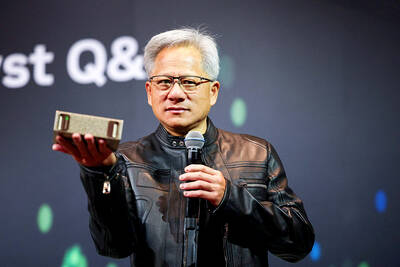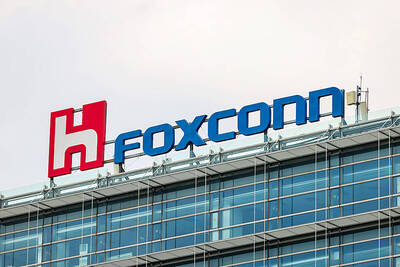The revelation that about US$2 million of “nickel” on the London Metal Exchange (LME) was actually just bags of stones has thrown a spotlight on the sprawling web of warehouses and metal stashes underpinning the billions of dollars of derivatives traded daily on the LME.
Over the past week, warehouse staff from Busan, South Korea, to Genoa, Italy, have rushed to check tens of thousands of two-tonne bags of nickel — in some cases, by literally kicking them.
The LME advised warehouse operators to wear steel toe-capped boots for safety, one person who received the instructions said.

Photo: AFP
The rule of thumb: If it hurts when you kick it, it is probably nickel.
The mass inspection, which also included more carefully calibrated checks such as weighing and scanning the bags, came after the LME last week announced it had discovered “irregularities” in nine nickel contracts.
The contracts — now invalidated — belonged to JPMorgan Chase & Co.
No other issues were found across the LME’s global network of warehouses, the exchange said on Thursday.
Attention will now turn to the question of how the bags of stones could have been bought and sold as nickel on the LME — long viewed by traders as the one place where they do not need to second guess the contents of their cargoes.
The first sign of trouble came after some of the bags of “nickel” were bought from an LME-registered warehouse in the Netherlands by two trading companies, Trafigura Group and Stratton Metals.
When the bags were delivered to them, their weights did not match the paperwork. Inside, rather than nickel briquettes — which look like lumps of charcoal for barbecuing — the bags had stones.
When the rest of the Dutch warehouse was searched, the bags underlying nine LME contracts belonging to JPMorgan were also found to contain stones.
There are two possible explanations: Either the bags were already full of stones when they were first delivered into Access World’s Rotterdam warehouse, or someone sneaked into the warehouse to steal the nickel.
Access World is leaning toward the second theory, because it has a record of the material being weighed when it first entered the warehouse, people familiar with the matter said.
It is far from the first time the metals industry has had to deal with scandals and theft, and nickel’s high value makes it a favorite of fraudsters.
Just last month, Trafigura said it had been the victim of a “systematic fraud” whereby it spent about US$600 million on cargoes of nickel that turned out not to contain the metal.
In 2017, banks lost more than US$300 million after discovering fake warehouse receipts for nickel stored in Access World warehouses in Asia — in that case, outside of the LME’s network.
Metals traders joke about how the oldest known written complaint — on a clay tablet housed in the British Museum — details a deal gone wrong over substandard copper.
However, in today’s world, the LME’s system is the one place where metal is assumed to be unquestionably safe.
The exchange’s contracts, which are the global benchmark for industrial metals such as copper, nickel and zinc, are backed by physical metal in the network of warehouses around the world.
While the vast majority of trades on the exchange are purely financial transactions involving hedge funds seeking to bet on the price of metals, or producers looking to hedge, anyone who holds a contract to expiry receives a parcel of metal in an LME-registered warehouse.
The whole system relies on warehouse companies to vouch for the metal they have loaded in when they produce an LME “warrant” — a warehouse receipt that can be delivered against an LME contract.
“Elevated prices on base metals make them a natural target for fraud and theft,” said Simon Collins, former head of metals at Trafigura and the CEO of digital trading platform TradeCloud. “Commodity companies need to protect themselves via stringent procedures around people, processes and technology.”
Access World has said it believes the nine warrants suspended by the LME were an isolated case, “specific to one warehouse in Rotterdam.”
A promotional video for the company’s facility in Rotterdam’s port area shows a brightly lit warehouse filled with stacks of shiny metal, as well as numerous security cameras.
One headache for investigators is that it is far from clear when any nefarious activity took place.
The material was first delivered into the Rotterdam warehouse several years ago, people familiar with the matter said.
It might have gone undetected for years, because of a quirk specific to the nickel market.
Unlike aluminum and copper, which are kept in neat stacks in warehouses, most of the nickel in the LME is in the form of briquettes in bags.
Warehousing and shipping companies typically do not look inside the bags, checking only that the seals have not been tampered with.
They issue warehouse receipts on what is called a “said to contain” basis — meaning they cannot vouch for the contents.

SEEKING CLARITY: Washington should not adopt measures that create uncertainties for ‘existing semiconductor investments,’ TSMC said referring to its US$165 billion in the US Taiwan Semiconductor Manufacturing Co (TSMC, 台積電) told the US that any future tariffs on Taiwanese semiconductors could reduce demand for chips and derail its pledge to increase its investment in Arizona. “New import restrictions could jeopardize current US leadership in the competitive technology industry and create uncertainties for many committed semiconductor capital projects in the US, including TSMC Arizona’s significant investment plan in Phoenix,” the chipmaker wrote in a letter to the US Department of Commerce. TSMC issued the warning in response to a solicitation for comments by the department on a possible tariff on semiconductor imports by US President Donald Trump’s

‘FAILED EXPORT CONTROLS’: Jensen Huang said that Washington should maximize the speed of AI diffusion, because not doing so would give competitors an advantage Nvidia Corp cofounder and chief executive officer Jensen Huang (黃仁勳) yesterday criticized the US government’s restrictions on exports of artificial intelligence (AI) chips to China, saying that the policy was a failure and would only spur China to accelerate AI development. The export controls gave China the spirit, motivation and government support to accelerate AI development, Huang told reporters at the Computex trade show in Taipei. The competition in China is already intense, given its strong software capabilities, extensive technology ecosystems and work efficiency, he said. “All in all, the export controls were a failure. The facts would suggest it,” he said. “The US

The government has launched a three-pronged strategy to attract local and international talent, aiming to position Taiwan as a new global hub following Nvidia Corp’s announcement that it has chosen Taipei as the site of its Taiwan headquarters. Nvidia cofounder and CEO Jensen Huang (黃仁勳) on Monday last week announced during his keynote speech at the Computex trade show in Taipei that the Nvidia Constellation, the company’s planned Taiwan headquarters, would be located in the Beitou-Shilin Technology Park (北投士林科技園區) in Taipei. Huang’s decision to establish a base in Taiwan is “primarily due to Taiwan’s talent pool and its strength in the semiconductor

French President Emmanuel Macron has expressed gratitude to Hon Hai Precision Industry Co (鴻海精密) for its plan to invest approximately 250 million euros (US$278 million) in a joint venture in France focused on the semiconductor and space industries. On his official X account on Tuesday, Macron thanked Hon Hai, also known globally as Foxconn Technology Group (富士康科技集團), for its investment projects announced at Choose France, a flagship economic summit held on Monday to attract foreign investment. In the post, Macron included a GIF displaying the national flag of the Republic of China (Taiwan), as he did for other foreign investors, including China-based